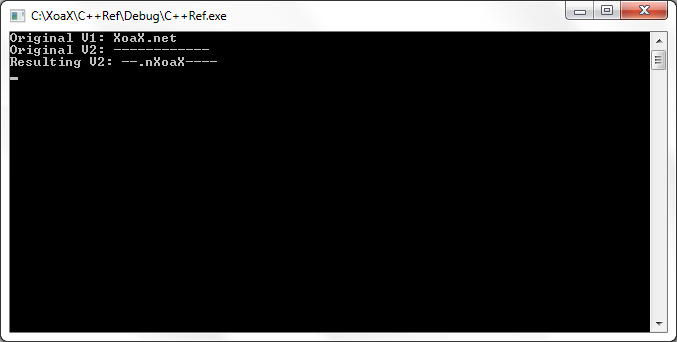algorithm - STL C++
rotate_copy()
Declaration
template <class ForwardIterator, class OutputIterator> OutputIterator rotate_copy( ForwardIterator xFirst, ForwardIterator xMiddle, ForwardIterator xLast, OutputIterator xDest );
Description
This function copies the rotated entries to the location specified by "xDest." The rotation is performed by rotating the range of entries starting at "xFirst" up to the one before "xMiddle" into the range up to the entry before "xLast." The result works a like a bitwise roll. The function returns an iterator that points to the element at the end of the copied range.Header Include
#include <algorithm>
Example
#include <iostream>
#include <vector>
#include <algorithm>
int main()
{
using namespace std;
// Create two vector instances
vector<char> qV1;
qV1.push_back('X');
qV1.push_back('o');
qV1.push_back('a');
qV1.push_back('X');
qV1.push_back('.');
qV1.push_back('n');
qV1.push_back('e');
qV1.push_back('t');
vector<char> qV2(12, '-');
vector<char>::iterator qIter;
// Output the vectors
cout << "Original V1: ";
for (qIter = qV1.begin(); qIter != qV1.end(); ++qIter) {
cout << *qIter;
}
cout << endl;
cout << "Original V2: ";
for (qIter = qV2.begin(); qIter != qV2.end(); ++qIter) {
cout << *qIter;
}
cout << endl;
// Copy the first six rotated entries of v1 into the third entry of v2
vector<char>::iterator qEndOfCopyIter;
qEndOfCopyIter = rotate_copy(qV1.begin(), qV1.begin()+4, qV1.begin()+6, qV2.begin()+2);
// Output the result vector
cout << "Resulting V2: ";
for (qIter = qV2.begin(); qIter != qV2.end(); ++qIter) {
cout << *qIter;
}
cout << endl;
// Keep the window open
cin.get();
return 0;
}Output

© 2007–2024 XoaX.net LLC. All rights reserved.
